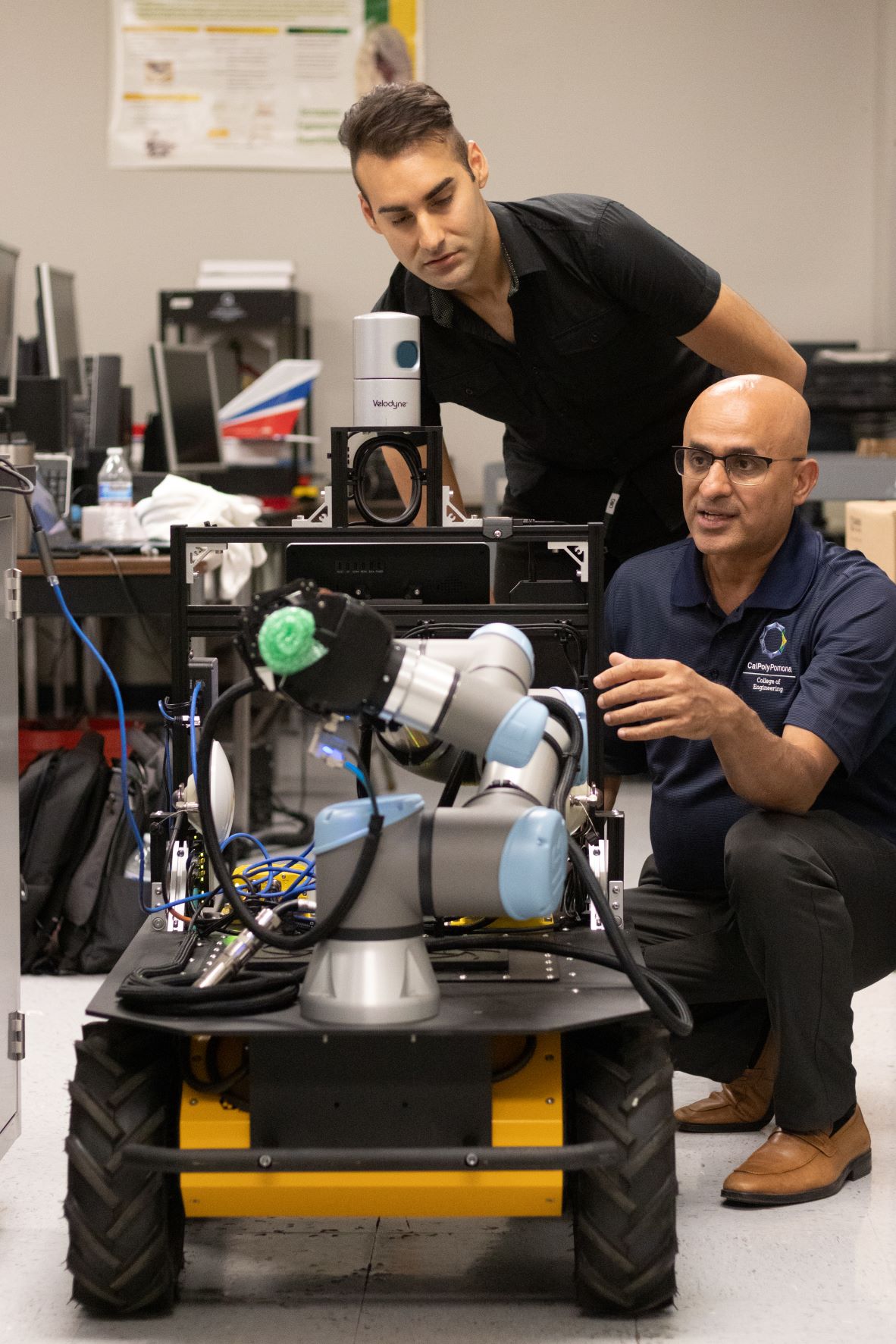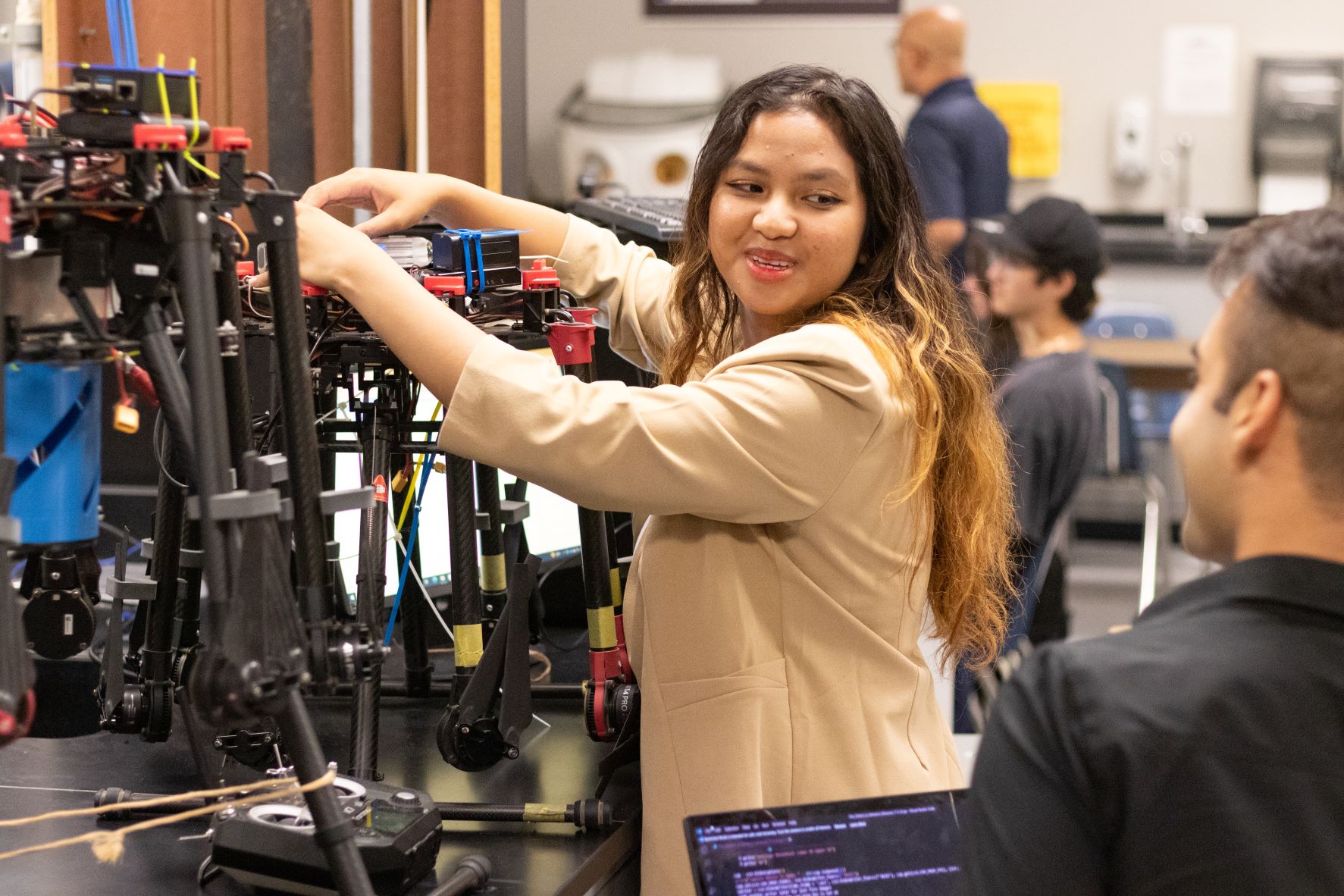Ready for Takeoff
$5 million from the Air Force Research Laboratory supercharges advanced drone technology.
By Marisa Demers
 In the future, our skies may be dotted with small flying machines tasked with delivering packages to our doorstep, monitoring traffic flow, and even helping with search-and-rescue missions. Once a tool for the military, unmanned aerial vehicles (UAVs), or drones, have found mainstream appeal for jobs too dangerous, time-consuming, or cumbersome for humans.
In the future, our skies may be dotted with small flying machines tasked with delivering packages to our doorstep, monitoring traffic flow, and even helping with search-and-rescue missions. Once a tool for the military, unmanned aerial vehicles (UAVs), or drones, have found mainstream appeal for jobs too dangerous, time-consuming, or cumbersome for humans.
Yet, engineers and computer scientists will need to push the limits of technology to realize that vision, says Subodh Bhandari, Ph.D., professor of aerospace engineering. The biggest challenge, he adds, is getting UAVs to “think” on their own.
“I want to make UAVs more like driverless cars,” says Bhandari. He works with UAVs that look like either helicopters or airplanes, weigh less than 55 pounds and fly at a maximum altitude of 400 feet. “Humans are supervising the action, but they are not actively maneuvering the vehicle. To harness the full potential of UAVs, we will need this level of autonomy.”
Thanks to funding secured for Cal Poly Pomona to advance the Educational Partnership Agreement (EPA) with the Air Force Research Laboratory (AFRL), Cal Poly Pomona is receiving $5 million for research to help the U.S. get closer to a more autonomous world. These funds will support seven UAV projects, and Bhandari will play a critical role in several of them. For instance, he is leading efforts to improve how UAVs detect and avoid collisions and help streamline communications between UAVs and other unmanned air and ground vehicles. With these advancements, humans can design more complex, multi-robot missions. Bhandari is also partnering with Cal Poly Pomona faculty to leverage remote sensing technologies to accurately monitor the quality of air, water, and crops as well as detect geographic hazards such as faults, landslides, and ground erosion.
As Bhandari embarks on each of these projects, he can freely focus on his research and students, and not worry about paying for state-of-the-art equipment.
“Faculty and students are working with UAVs and sensor technologies that are actually used in industry,” Bhandari says. “This is an invaluable experience and would not be possible without this level of support.”
“This is an invaluable experience and would not be possible without this level of support.” Subodh Bhandari, Ph.D., Aerospace Engineering Professor
For nearly 20 years, Bhandari’s research has pushed forward the autonomous capabilities and real-world applications of UAVs. Most recently, he has helped farmers customize the amount of nutrients, fertilizer, and pesticides that crops receive, a practice known as precision farming. Instead of relying on grainy satellite images or expensive manned flights, UAVs fly over vast swaths of farmland and take high-resolution photographs of crops. Then, a sophisticated machine learning algorithm identifies plants that need attention. Bhandari’s approach has helped farmers increase their yield on strawberry crops, detect powdery mildew on grapes, and identify weeds that need to be removed.
Bhandari dedicated his research career to UAVs in the early 2000s while he was in graduate school. At the time, they were not widely studied outside of the military even though UAVs have been in existence for more than a century. Today, the UAV industry has grown exponentially. The number of UAV patents more than doubled between 2016 and 2018, and its market size is valued at approximately $22 billion.
Aerospace engineering student Eve Javier did not know about UAVs until she transferred to CPP and was invited to do summer research with Bhandari. Now, she gets a thrill when she sends her UAVs on a test flight.

Collaborating with electrical, mechanical, and robotics engineers, Javier worked on programming UAVs to detect and extinguish forest fires. Still in the proof-of-concept stage, the group customized two UAVs with sensors, thermal-imaging cameras and onboard computers. Ultimately, the team wants one vehicle to detect a fire and send the geographic coordinates to the second UAV. Then, the second UAV will visit the site and drop a fire suppression ball. Encouraged by the team’s progress and the real-world need to address this challenge—since 1983 there have been an average of 70,000 wildfires a year—Javier plans to continue this research throughout the school year.
Participating in the summer project gave Javier new insight into robots and, more importantly, her fellow humans.
“Coming from various disciplines, the group struggled to find our groove in the beginning,” Javier says. “We each had different perspectives and methods on how to approach this project. Each member had to figure out how to be part of a team, and I am so glad we did because we all learned from each other.”
If Javier decides to pursue a career in UAV engineering after graduation, she will be joining several other Cal Poly Pomona engineering alumni who are employed at AFRL, Lockheed Martin Corporation, and Boeing.
“UAVs is one of the fastest growing sectors in the aerospace industry,” Bhandari says. “Yet, there are not a lot of people who are qualified to work in this area. Funding, which helps accelerate our EPA with the Air Force Research Laboratory, will enable Cal Poly Pomona student and faculty researchers to help the U.S. maintain its global leadership in technology and innovation by continuing to provide a skilled and diverse workforce pipeline.”
Caption for first photo: Subodh Bhandari, Ph.D., aerospace professor, instructs aerospace engineering student Rick Ramirez on utilizing the unmanned ground vehicle (UGV) for autonomous UAV-UGV mission coordination.